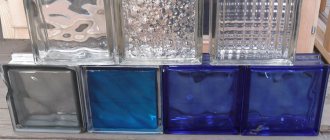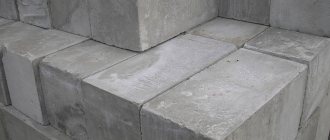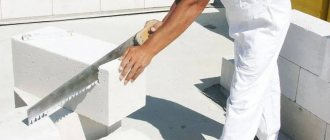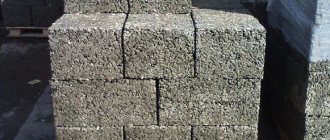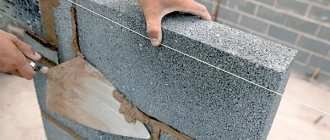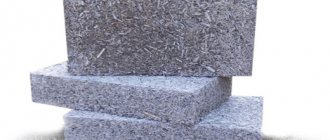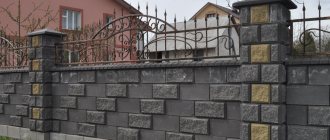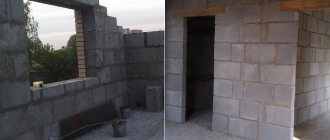Block characteristics
The basis of such blocks is polystyrene concrete, and polymer granules are used as filler. Such blocks can be either hollow or solid.
A special feature of this material is that, despite its low weight, it has high compression and tensile strength.
Dimensions
To create interior partitions, polystyrene concrete slabs measuring 588x600x92 mm , but there may be other sizes, it all depends on the manufacturer.
The weight of partition slabs ranges from 5-15 kilograms .
Depending on the density of the material used, slabs can have a strength from 150 to 600 kg/m3, according to which they are assigned a grade from D 150 to D 600.
To create internal non-load-bearing partitions, blocks D 150 – D 300 are used . For internal load-bearing walls, it is necessary to take wall blocks D 350 - D 500, and for external walls, blocks D 550 and higher are used.
If we compare polystyrene concrete with foam concrete or aerated concrete, its thermal conductivity coefficient is lower. This material has good frost resistance, and its water absorption is only 4%.
pros
Even if the walls get wet, they dry quickly, which allows this material to be used for constructing partitions in a bathroom or toilet.
Polystyrene concrete has good vapor permeability , so walls and partitions built from it can “breathe,” which reduces the likelihood of mold and mildew to a minimum.
It is also convenient that polystyrene concrete is quite easy to cut , this can be done using a hand saw, and the fact that the slabs are large in size and relatively light allows the process of building partitions to be carried out quickly and simply, allowing you to make decorative partitions for zoning space in an office or zoning in an apartment room.
The presence of keyways allows the solution to be placed in them. There should be enough of it to fill the keyway in the top and bottom rows, and any excess should be removed immediately.
Vertical grooves are filled with glue after laying the row. Above the doorway, in order to strengthen the partition structure, it is necessary to lay reinforcement in the horizontal keyways.
Minuses
Due to the low density of the material, hanging a shelf or attaching a cabinet will be problematic; ordinary dowels and nails will not hold; special fasteners and liquid anchors are required.
In case of fire, phenol is released, which is hazardous to health due to the content of foam balls in the block.
Features of building a house made of polystyrene concrete
Building a house is a complex multi-stage process that requires at least basic specialized knowledge. In general terms, building a house made of polystyrene concrete looks like this:
arrangement of the foundation. Since the overall weight of the structure is small, a columnar, shallow strip or pile foundation can be used. For complex types of soil, it is better to choose a screw pile; construction of walls using the chosen technology: from blocks, with removable or permanent formwork. Construction from blocks begins with waterproofing work and determining the highest place from which the laying of walls begins. When laying, verticality and horizontality are strictly observed using a fishing line and a level. To increase strength, reinforcing mesh can be laid horizontally. If blocks with solid voids are used, vertical reinforcement is performed. The thickness of the mortar seam is no more than 8 mm; it is better to use special glue. Monolithic walls are erected using removable formwork made of 15 mm thick plywood, which is protected from moisture with a polyethylene film. The plywood is held in place through the use of metal profiles; they are attached to the foundation with self-tapping screws or dowels. Sheets of plywood are attached to the profiles; first, external partitions are created, then internal ones. When pouring, the solution compacts well; the formwork can be dismantled after a few days. Instead of plywood, you can use brick walls - this is permanent formwork, and no façade cladding is required; The ceiling is made from special polystyrene concrete panels or also by pouring. Floor screeding is performed using standard methods; exterior finishing of a house made of polystyrene concrete is necessary. You can use decorative brick, siding, and plaster. Inside, you also first need a layer of plaster, then putty, and then whatever you want: wallpaper, painting, decorative plaster. A house made of polystyrene concrete can be built in a matter of months, and if all the features of the technology are observed, it will stand for decades. Most importantly, do not forget about high-quality ventilation and specific fasteners.
Masonry
The internal walls of the house and partitions are erected after the construction of the main walls is completed.
First, mark the location of the partitions on the floor, then use a level and plumb line to mark their location on the walls.
When creating the markings, do not forget to note the location of the doors. If the partition is being built in an already residential space, then its projection is made both on the floor and walls, and on the ceiling.
To complete the work you will need:
- container for adhesive composition;
- mixer;
- putty knife;
- rubber hammer;
- hacksaw;
- measuring instruments;
- building level;
- plumb line
The working surface must be pre-leveled; this is done using ordinary cement mortar. When the screed has dried, remove any dirt and dust from it, and use a building level to check the horizontalness again.
Laying of polystyrene concrete blocks can be carried out either with sand-cement mortar or with special glue.
The latter option is more preferable, especially when creating external walls, since in this case, the seams are thin and cold bridges do not form, as when using cement mortar.
To create internal partitions, thermal insulation characteristics are not so important, so cement mortar can be used.
The adhesive is applied using a trowel over the entire width of the block and leveled. In this case, special attention is paid to the correct installation of the first row, since the appearance and strength of the future partition will depend on this.
To simplify the process of laying subsequent rows, you can install beacons, between which you stretch a fishing line and use it to control the correctness of the laying.
Styling adhesive
In order to save money, some novice craftsmen believe that it is better to use sand-cement mortar than special glue. At first glance, this may seem more economical, but one must take into account that although cement mortar is cheaper, it is consumed 2-3 times more than glue and therefore, even if savings are obtained, it will be insignificant.
When using glue, the blocks fit more tightly to each other and there are minor gaps between them, about 2-5 mm, whereas when using a regular mortar, the seam thickness will be 10-12 mm.
When using conventional mortar for laying walls made of polystyrene concrete, their thermal insulation characteristics deteriorate, causing condensation and dampness to appear in the house, which leads to the development of fungus and mold.
In addition, when using sand-cement mortar, due to the large thickness of the seams, the result may be an uneven wall , and its strength will be reduced. That is why, if you are installing partitions and polystyrene concrete yourself, it is best to use special glue.
Disadvantages of polystyrene foam blocks
- The blocks cannot withstand high temperatures. The maximum temperature is 90ºС.
- The blocks are a fire hazard. Additional fire safety measures are required.
- Blocks are easy to damage. Despite its apparent strength, the block is easy to pierce even with a finger. It is necessary to putty the walls.
In addition, some argue that polystyrene foam, like any “chemicals”, is not environmentally friendly and even harmful. I cannot categorically refute this fact. There are various requirements, GOST and standards, including sanitary ones, polystyrene foam blocks fully comply with them. But sometimes it’s hard to convince a person of what seems obvious. This is where the psychological factor comes into play. Although polystyrene foam has been widely used for a long time for interior decoration and insulation of buildings.
The cost of a polystyrene foam block is about 4-5 USD. In principle, this is a normal price. For comparison, you can calculate the total construction costs, for example, of brick. Thermohouse provides you with a wall ready for finishing both inside and outside the house. In finishing you can use almost any materials: putty, bark beetle plaster, wallpaper, paint, siding, etc. In a house built of brick, you will need to plaster and putty at least the internal walls, and also insulate the surfaces with the same polystyrene foam, which will be even more expensive.
Thus, you should not be afraid of the high price, because it already includes finished, finished, insulated walls. Profitable? Yes, I think so!
At the moment, GOST allows the construction of thermal houses up to 15 meters high, which is already 4-5 floors.
Recommendations from experts
In order for you to get a strong, reliable and even partition made of polystyrene concrete, you must adhere to the following recommendations from experts:
- constantly monitor the evenness of laying the slabs;
- lay the first row, check its horizontalness, let the glue set and only then proceed to laying the next rows;
- It is better to lay with glue than with cement mortar. Although the cost of glue will be higher, its consumption is several times less, and the strength, heat and sound insulation characteristics of the partition will be much higher;
- glue that has gone beyond the block must be removed immediately, as it sets quickly and will be difficult to remove later;
- if you need to hide communications in partitions, then it is better to make a partition from plasterboard
Polystyrene concrete monolith Simprolit density D200-400 - Moscow
Hello, dear gentlemen! We present to your attention Simprolit monolith - this is an encapsulated, modified polystyrene concrete of a new generation. Due to special additives and the highest quality components (ready-mixed concrete grade B40 (M550), foamed food grade polystyrene, special additives), excellent thermal conductivity (0.055 W/mK for D250) and compressive strength (0.40 N/mm2) are achieved. Simprolit monolith also received an NG fire safety certificate. Polystyrene concrete Simprolit monolith is used: 1. For insulation, sound insulation of flat roofs, foundation slabs and walls, as a protective layer for waterproofing. For installing a slope-forming layer on flat roofs. If the load-bearing element of the roof is corrugated sheeting, Simprolit monolith increases the fire resistance of the roof (when using slab insulation, the corrugations form a system of channels with an open cross-section, in which, in the event of a fire, draft occurs and the fire quickly spreads), protects the roof made of corrugated sheets from corrosion, roofs made of corrugated sheets overall it becomes more rigid. 2. For the installation of lightweight concrete cement screed, which, unlike heavy concrete, has the function of thermal insulation and sound absorption. In addition, the weight of the Simprolit screed is 50 mm thick. (20 kg/m2), 5 (!) times lower than a similar cement-sand screed (100 kg/m2). 3. To fill non-design voids during the reconstruction of buildings. The low specific gravity, coupled with high strength characteristics, allows this method to be widely used without significantly increasing the load on the structure. When using Simprolit monolith as a lightweight concrete cement screed, the load on the structural elements of the building is significantly reduced, and, consequently, their dimensions, the necessary reinforcement and the weight of load-bearing elements are reduced, which directly affects the cost of the building structure (for example, in a 9-story building, the the load on the foundation is more than 1 tone/m2, and, accordingly, on the structural elements of each floor). Simprolit monolith is manufactured directly at the construction site and poured using a gerotor pump Edilteco RM-1000 (horizontal delivery up to 80 m, vertical delivery up to 26 m)
Polystyrene concrete monolith Simprolit density D200-400 - sale in Moscow. From us you can purchase the product “Polystyrene concrete monolith Simprolit density D200-400” at a price that can be clarified by phone. In order to buy this product, click on the “Show phone” button.


